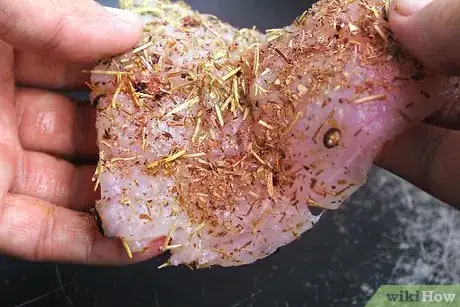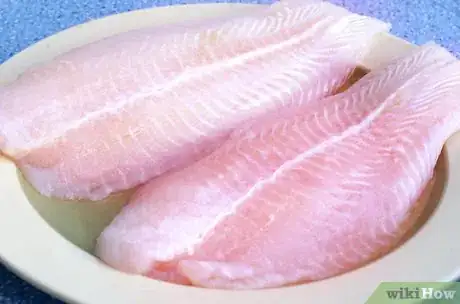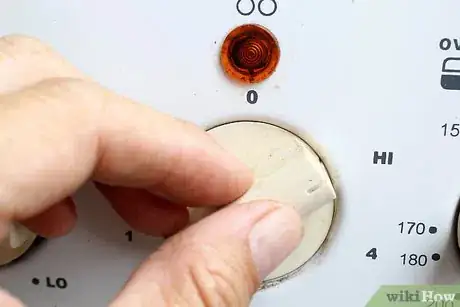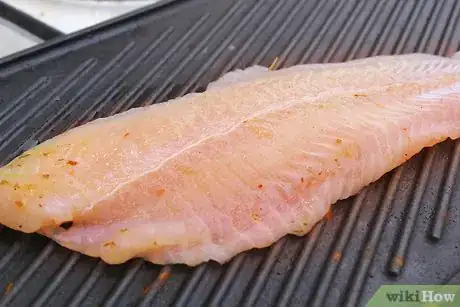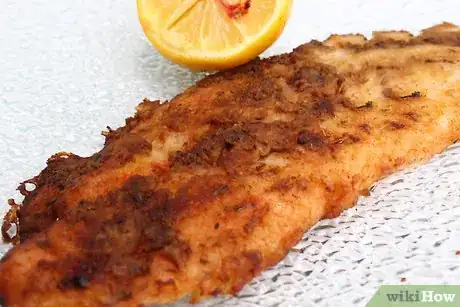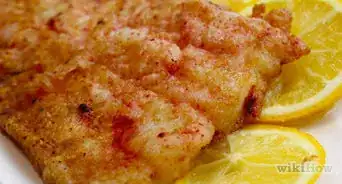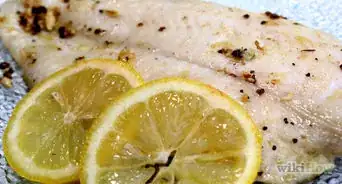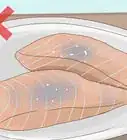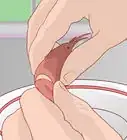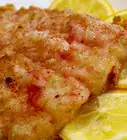This article was co-authored by Ed Kuoha. Ed Kuoha is a Chef and the Owner of Kuoha Culinary based in Aiea, Hawaii. He has more than 20 years of experience in various culinary kitchens and settings such as Morimoto Waikiki, where he received hands-on training from Iron Chef Morimoto. Chef Ed specializes in small catering events and private chef requests. He holds an Associate’s degree from The Culinary Institute of the Pacific at Kapiolani Community College.
There are 14 references cited in this article, which can be found at the bottom of the page.
This article has been viewed 144,349 times.
Redfish, also known as red drum, is a tasty white fish that you can cook in a variety of ways. For a quick meal, try sautéing it in a skillet or cooking it on the grill. For a Cajun flavor, try a blackened redfish with plenty of spices.
Ingredients
- 1.5 to 2 pounds (0.68 to 0.91 kg) of redfish fillets
- 0.25 cups (59 mL) of olive oil
- 1 teaspoon (0.8 g) of fresh thyme, chopped
- 1 tablespoon (2.6 g) of fresh basil, chopped
- Salt and pepper to taste
- 3 lb (1,400 g) of redfish fillets
- 0.25 cups (59 mL) of olive oil
- Salt and pepper to taste
- 1 lemon, cut into wedges
- 3 lb (1,400 g) of redfish fillets, 0.5 in (1.3 cm) thick
- 1 tablespoon (7 g) of sweet paprika
- 1 1/2 teaspoons (9 g) of salt
- 1 teaspoon (2.5 g) of onion powder
- 1 teaspoon (1.7 g) of cayenne pepper
- 1 1/2 teaspoons (4 g) of ground pepper, black or white
- 1/2 teaspoon (0.5 g) of dried thyme
- 1/2 teaspoon (0.5 g) of dried oregano
- 12 tablespoons (170 g) of melted butter
Steps
Making Simple Sautéed Redfish
-
1Season the fish with olive oil, basil, thyme, salt, and pepper.[1] Use your hands to massage 1 tablespoon (15 mL) of olive oil into both sides of the fish. Sprinkle salt and pepper on both sides of the fish. Press 1 teaspoon (0.8 g) of fresh, chopped thyme and 1 tablespoon (2.6 g) of fresh, chopped basil into the flesh side of the fish only.[2]
- If you don't have fresh herbs, add a sprinkling of dried herbs, such as 1 teaspoon (0.5 g) of basil or rosemary, 1 teaspoon (1 g) of thyme, or 1 teaspoon (0.6 g) of rosemary. Italian seasoning in similar measurements would also work.
-
2Heat 1 tablespoon (15 mL) of olive oil in a skillet over medium heat.[3] Pick a nonstick skillet to make cooking easier. Let the oil heat up for a few minutes before you add the fish. It will have a light shimmer when it's ready.[4]Advertisement
-
3
-
4Flip the fish to cook it for another 4 minutes or so.[7] Turn the fish over so it's skin-side down. Be gentle, as the fish will break into pieces if you handle it too roughly. Use a spatula to turn it.[8]
- The fish is done when it flakes easily with a fork.
- Serve the fish with a side of rice or sautéed spinach.
- You could add a pat of butter or a squeeze of lemon on top of the fish at the end.
Making Grilled Redfish
-
1Prepare the redfish fillets by washing them and slitting the skin. Rinse the fish under cool, running water, and pat it dry. Moisture will make the skin steam instead of crisping up.[9] Some chefs prefer to make a few cuts along the skin. Simply make shallow diagonal slices in the skin from top to bottom every 1 in (2.5 cm) or so to allow moisture through.[10]
- If you prefer, you can cook the fish without the skin.
-
2Brush the skin side with a 0.25 cups (59 mL) of olive oil. Dip a pastry brush into the olive oil and brush it evenly over the fish to create a nice, light coating. Make sure you coat all of the skin with olive oil.[11]
- Don't reuse any leftover olive oil unless you heat it up to kill the bacteria.
-
3Turn the fish over and season it lightly. Lay the fish skin-side down on a baking sheet. Season the flesh of the fish with salt and freshly ground pepper to your liking, starting with 1 1/2 teaspoons (9 g) of salt and 1 1/2 teaspoons (4 g) of pepper.[12]
- You can also use other seasonings at this point. For instance, you can sprinkle 1 teaspoon (2.5-3.2 g) of onion or garlic powder over the fish, or add a dash of cayenne pepper or red pepper flakes.
-
4Warm the grill to medium heat and oil it down. Aim for a temperature of 350 to 375 °F (177 to 191 °C), whether you're working on a gas grill or charcoal grill. Make sure the grill is very clean before you put the fish down, as it will stick if it's not.[13]
- Rub oil across the grill to keep the fish from sticking. Use enough to coat the grate, but be careful not to burn your hands.
-
5Cook the fish on the grill for 5-6 minutes on one side. Place the fish on the grill, skin-side down. Wait about 5 minutes, then check to see if the skin has crisped up. If it has, you're ready to turn the fish. If not, wait another minute or 2.[14]
-
6Flip the fish and cook it another 3-4 minutes. Carefully turn the fish over with a spatula. It's fragile, so be gentle. You don't want to break it up as you flip it. Let it cook on the flesh side for another 3 minutes or so until the fish flakes easily.[15]
-
7Let the fish rest off the grill and then serve it. Move the fish to a serving platter and let it sit for about 5 minutes. Squeeze some fresh lemon over the fillets, and serve it with grilled or steamed veggies.[16]
- You can also add a sprinkle of fresh parsley over the top.
Cooking Blackened Redfish
-
1Mix the seasonings together to form a spice mix. Add 1 tablespoon (7 g) of sweet paprika, 1 1/2 teaspoons (9 g) of salt, 1 teaspoon (2.5 g) of onion powder, 1 teaspoon (1.7 g) of cayenne pepper, 1 1/2 teaspoons (4 g) of ground pepper (black or white), 1/2 teaspoon (0.5 g) of dried thyme, and 1/2 teaspoon (0.5 g) of dried oregano to a small bowl. Stir to combine the ingredients.[17]
- You can use equal amounts of black and white pepper or just pick one or the other.
-
2Melt 6 ounces (170 g) of butter in the microwave. Put the butter in a microwave-safe dish and set it in the microwave. Cover the dish and heat the butter in 30-second bursts until it is completely melted.[18]
- Some recipes call for clarifying the butter, which means you heat it and then remove the top layer of butter that naturally separates from the rest by skimming it off with a spoon. That layer of butter burns more readily than the rest of it, so removing it makes for less smoke.[19]
-
3Season the fish with the prepared seasoning. Sprinkle a generous amount on both sides of the fillets; use all of the seasoning for 6 fillets. Press the seasoning into the fish gently with your hands.[20]
-
4Heat a cast-iron skillet over medium-high to high heat. Set the skillet on hot coals in a charcoal grill. The coals should be dull black with an ashy coating, not white hot. For a gas grill, set it on medium-high heat.[21]
- You can do this inside on the stove, but you need to open the windows to vent the smoke outside. The high heat required will produce a lot of smoke.[22]
-
5Add butter to the pan. Pour 0.5 to 1 ounce (14 to 28 g) of butter into the pan where you will place each fillet. You'll only need 2-3 buttered areas to start with, as you can't cook all the fillets at once.[23]
- The pan will smoke a lot, so be prepared and stand back.
-
6Place 2-3 fillets in the pan to cook for 2 minutes on 1 side. Add a fillet in each pool of melted butter. Let it cook on that side for about 2 minutes. Lift up the edge of the fillet to see if the bottom is charred. If it is, it's time to flip it.[24]
-
7Flip the fish and add a bit more butter. When the bottom is charred, use a spatula to turn the fish over. Pour 1 teaspoon (4.9 mL) or so of melted butter over each fillet after you've flipped them.[25]
- You don't have to measure the butter. Just pour a splash of melted butter over each fillet.
-
8Cook another 2-3 minutes until the fish is done. The other side of the fish should be charred when it's done. To test to see if the fish is cooked through, gently press on the thickest part of the fish. If it leaves an indention in the fish, it's done.[26]
-
9Cook the other 2-3 fillets the same way. Once you take the first batch out of the pan, move on to the other fillets. You can put the first fillets in your oven at the lowest temperature your oven has to keep them warm until the others are ready. Aim for 170 to 200 °F (77 to 93 °C).[27]
- Some cooks prefer to serve the fish with a small dish of melted butter on the plate.
Expert Q&A
-
QuestionDo I need to remove the skin?
 Ed KuohaEd Kuoha is a Chef and the Owner of Kuoha Culinary based in Aiea, Hawaii. He has more than 20 years of experience in various culinary kitchens and settings such as Morimoto Waikiki, where he received hands-on training from Iron Chef Morimoto. Chef Ed specializes in small catering events and private chef requests. He holds an Associate’s degree from The Culinary Institute of the Pacific at Kapiolani Community College.
Ed KuohaEd Kuoha is a Chef and the Owner of Kuoha Culinary based in Aiea, Hawaii. He has more than 20 years of experience in various culinary kitchens and settings such as Morimoto Waikiki, where he received hands-on training from Iron Chef Morimoto. Chef Ed specializes in small catering events and private chef requests. He holds an Associate’s degree from The Culinary Institute of the Pacific at Kapiolani Community College.
Chef Not at all! I always leave the skin on when cutting the fish into fillets both for cooking and for presentation.
Not at all! I always leave the skin on when cutting the fish into fillets both for cooking and for presentation. -
QuestionDo you cook fish on high or low heat?
 Ed KuohaEd Kuoha is a Chef and the Owner of Kuoha Culinary based in Aiea, Hawaii. He has more than 20 years of experience in various culinary kitchens and settings such as Morimoto Waikiki, where he received hands-on training from Iron Chef Morimoto. Chef Ed specializes in small catering events and private chef requests. He holds an Associate’s degree from The Culinary Institute of the Pacific at Kapiolani Community College.
Ed KuohaEd Kuoha is a Chef and the Owner of Kuoha Culinary based in Aiea, Hawaii. He has more than 20 years of experience in various culinary kitchens and settings such as Morimoto Waikiki, where he received hands-on training from Iron Chef Morimoto. Chef Ed specializes in small catering events and private chef requests. He holds an Associate’s degree from The Culinary Institute of the Pacific at Kapiolani Community College.
Chef I prefer working on medium heat so that the skin does not shrink up too fast and fold once it hits the pan. This way, it will gradually crisp up and stay flat!
I prefer working on medium heat so that the skin does not shrink up too fast and fold once it hits the pan. This way, it will gradually crisp up and stay flat!
References
- ↑ Ed Kuoha. Chef. Expert Interview. 9 November 2021.
- ↑ https://www.myrecipes.com/recipe/sauteed-redfish
- ↑ Ed Kuoha. Chef. Expert Interview. 9 November 2021.
- ↑ https://www.myrecipes.com/recipe/sauteed-redfish
- ↑ Ed Kuoha. Chef. Expert Interview. 9 November 2021.
- ↑ https://www.myrecipes.com/recipe/sauteed-redfish
- ↑ Ed Kuoha. Chef. Expert Interview. 9 November 2021.
- ↑ https://www.myrecipes.com/recipe/sauteed-redfish
- ↑ https://www.finecooking.com/recipe/grilled-redfish-with-onions
- ↑ https://www.wideopenspaces.com/5-red-fish-recipes-image/
- ↑ https://www.wideopenspaces.com/5-red-fish-recipes-image/
- ↑ https://www.finecooking.com/recipe/grilled-redfish-with-onions
- ↑ https://www.finecooking.com/recipe/grilled-redfish-with-onions
- ↑ https://www.wideopenspaces.com/5-red-fish-recipes-image/
- ↑ https://www.finecooking.com/recipe/grilled-redfish-with-onions
- ↑ https://www.wideopenspaces.com/5-red-fish-recipes-image/
- ↑ https://www.saveur.com/article/Recipes/Blackened-Redfish
- ↑ https://www.saveur.com/article/Recipes/Blackened-Redfish
- ↑ https://louisiana.kitchenandculture.com/recipes/blackened-redfish
- ↑ https://www.saveur.com/article/Recipes/Blackened-Redfish
- ↑ https://louisiana.kitchenandculture.com/recipes/blackened-redfish
- ↑ https://www.saveur.com/article/Recipes/Blackened-Redfish
- ↑ https://louisiana.kitchenandculture.com/recipes/blackened-redfish
- ↑ https://www.saveur.com/article/Recipes/Blackened-Redfish
- ↑ https://www.saveur.com/article/Recipes/Blackened-Redfish
- ↑ https://louisiana.kitchenandculture.com/recipes/blackened-redfish
- ↑ https://www.saveur.com/article/Recipes/Blackened-Redfish



